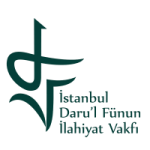CALL FOR BOOK CHAPTER (INTERNATIONAL): ISLAMIC SCIENCES IN THE HIJRI FOURTH CENTURY
We invite you to
contribute as a chapter author to an edited book titled ‘Islamic Sciences in
the Hijri Fourth Century,’ which will be published as an e-book by an international
publishing house. Please consider the following aspects for your proposed
chapter.
Justification
It is very important to learn how Islamic sciences started and how they developed in the first centuries. In order to see the point reached in the later periods and today and to understand how it has evolved, it is necessary to know the emergence and development process well.
We systematically delve into the first century and subsequent centuries in order to facilitate the identification of how Islamic sciences emerged, the conditions under which they manifested, and the processes they underwent. Within this framework, we dedicate individual books to each century, scrutinizing Islamic sciences comprehensively and striving to trace their development up to the present day. Through this approach, we aim to explore the genesis and evolution of foundational Islamic sciences, the subjects that initiated them, the trajectory they followed, and the extent to which they align with our contemporary understanding. Additionally, we seek to examine whether there is any relevance between these historical developments and the challenges facing the Islamic world today. Our objective is to shed light on historical ruptures, changes, and divergences that may have occurred during the course of history, ultimately contributing to Islamic knowledge, culture, and civilization.
We also try to determine in which centuries, in terms of Islamic sciences, more scientific activities and services were presented, which centuries were richer and brighter in terms of scientific activities, in which centuries scientific studies were weak and insufficient; what is the relationship between the rich or weak scientific activities with the general course of those centuries, administration, politics and socio-cultural situations, how social conditions play a role in the decrease and increase of scientific activities, their quality or weakness; under which conditions sciences diversified and enriched, which conditions regressed scientific studies, whether scientific services and activities have a relationship with geographical regions and factors such as people, climate and nature in those regions, if scientific activities diversified and enriched in any region in any century, what factors were effective in this.
Previous Studies
We tried to reveal the birth, establishment and blooming of Islamic sciences in the first century of Hijri with the title of “Islamic Sciences Through Centuries: International Symposium of the First Century of Hijrah”. In the birth and discovery of Islamic sciences, we tried to show the place and role of the Prophet and his Companions. Likewise, in this century, we tried to show the position and influence of scholars from the Followers generation (tâbiûn) in the development of Islamic sciences. We have tried to highlight the developments in this century, their causes, consequences and their reflections on the next centuries. With this purpose in mind, our edited book project, comprising articles from 16 different countries, underwent a peer-review process, and 50 of them were selected to be published as an e-book under the name of Islamic Sciences in the First Century of Hijri (Istanbul: Ensar Publications, 2020, 2 volumes).
We continued this activity, which we took a break in 2021 due to the pandemic, in 2022 with the title of “Islamic Sciences in the Second Century, and we covered the developments in the field of Islamic sciences in this century. In the first thirty-five years of this century, the influence of the Tabiun generation continues. After them comes the generation of The Tābiʿū al-Tābʿīn who grew up at their knees. We examined the contribution of all these to the development of Islamic sciences. We examined Imam Abu Hanifa and Imam Malik, who are among the most important figures of this century, and their scientific activities. We revealed the sects that emerged in this period, their effects on the following periods, the scholars who came to the fore in fields such as tafsir, hadith, fiqh, theology, akaid, mysticism, Arabic language and rhetoric, recitation, sirah, Islamic history, history of religions, their works and their effects in various aspects. We tried to introduce the first founding texts written in these fields and the founding persons who gave life to these texts with various studies. In addition, we tried to deal with the mihna incident and translation activities, which are important matters due to their emergence in this century. For this edited book as well, we received around 100 submissions from 14 different countries. Following a rigorous peer-review process, these works were compiled and published as an e-book titled ‘Islamic Sciences in the Second Century of Hijra’ (Ankara: IKSAD Publications, 2022, 5 volumes).
In 2023, we continued our series under the title ‘Islamic Sciences in the Third Century of Hijra,’ where we explored the developments in the field of Islamic sciences during this century. In this volume, we delved into the role of the third century Hijra in the development of various sciences within the Islamic realm. In this study, we have discussed the important names and important works of the third century of Hijri in the fields of tafsir, hadith, fiqh, theology, history of sects, Sufism, Arabic language, Qiraat, as well as history, Sirat, geography, astronomy, and literature. This century is the golden age of hadith. The most important names in the field of hadith, especially Bukhārī and Muslim, and the most authoritative works such as Sahīh al-Bukhārī and Sahīh al-Muslim came into existence in this century. Scholars such as Imam Shafi’i and Ahmad b. Hanbal were also treated as very important figures of this century because their death dates were in this century. Personalities such as Bakiy b. Mahled, Yahya b. Sallām, and many other scholars and their works were also discussed in this context. This century is a century in which very important events such as translation activities and extremely sad events such as Mihna were effective; in this respect, these were also examined.
Our book series received significant attention, with approximately 75 submissions from various countries. These submissions underwent scrutiny by the editorial board, ensuring compliance with specified technical requirements, and those that did not meet the criteria were eliminated. Subsequently, the approved submissions were sent to the Science and Advisory Board members for peer review. Based on the reports received from the Science and Advisory Board, some works were excluded, and others were requested to make corrections within a specified timeline. As a result, 70 works were included in the series. Among them, 34 chapters by 38 scholars and 1 English chapter by 2 scholars were published as an e-book under the title ‘Islamic Sciences in the Third Century of Hijra’ (Ankara: IKSAD Publications, 2023). Additionally, 35 Arabic chapters by 40 scholars were printed in Morocco under the title al-Ulūm al-Islāmiyya fī al-Qarn al-Thālith al-Hijrī (al-Dār el-Maghribiyye li’n-Nashr wa al- Tawzī‘, 2023).The printing process of both works will be completed in the near future and will be realised in 2023.
Symposium of The Place Of The Hijri Fourth Century In The Development Of The Islamic Sciences
In 2024, we aim to publish our book titled ‘Islamic Sciences in the Fourth Century of Hijra.’ Stay tuned for further updates and contributions to this ongoing exploration of Islamic science.
Why Hijri Fourth Century
Like the previous three centuries, the fourth century of Hijri is very important for the Islamic religion and Islamic sciences. We can think of the Hijri first century as a century in which the seeds of Islamic sciences were scattered in the soil and flourished, and the Hijri second century as a century in which Islamic sciences grew and became saplings. The Hijri third century is a century in which these trees now bear fruit and produce bountiful crops. The fourth century is a century in which the fruits ripen and reach their full consistency. We are planning to process this century, in which the products ripen and reach maturity, in various aspects in 2023. Here, when we say the fourth century of the Hijri, we mean the period between the years AH 300-399 and AD 913-1009 in terms of time; in terms of space, we mean the Islamic geography, one end of which is based on the Great Wall of China and the other on the Adriatic Sea and the French border in Andalusia.
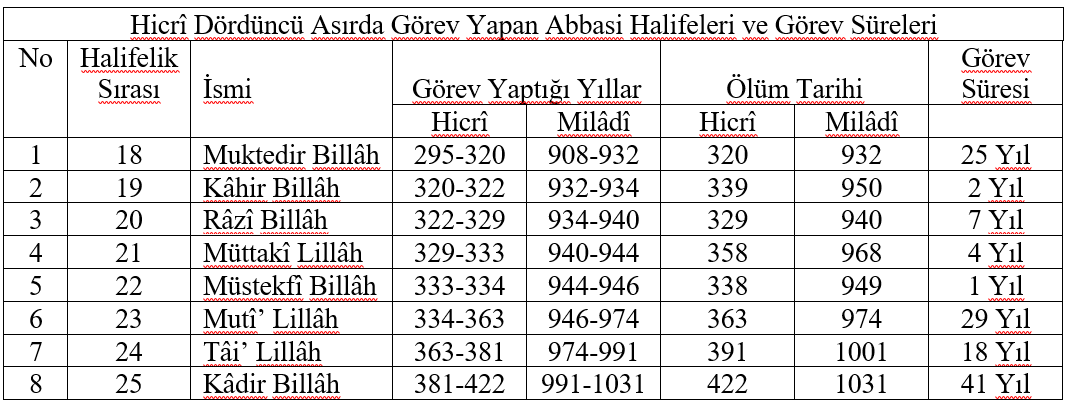 In the fourth century of Hijri, eight
In the fourth century of Hijri, eight
caliphs held office. Although these caliphs could be effective in the
administration from time to time, they were mostly under the influence of some
other states which were powerful at that time. The election, dethronement and
punishment of the caliph were mostly according to the wishes of the rulers of
these states. At the beginning of the century, the eighteenth caliph of the Abbasids, Muqtadir Billāh (caliphate 295-320/908-302), served as caliph. Muqtadir Billāh, who became caliph towards the end of the third century, continued his caliphate in the first twenty years of the fourth century. He held this position for about 25 years, which makes him one of the longest caliphs. The century ended during the caliphate of al-Qādir Billāh (381-422/991-1031). Qādir Billāh’s rule lasted 41 years, making him the second longest-serving Abbasid caliph. At the beginning of this century, Abdurrahman III (300-350/912-961) was in charge in the Andalusian Umayyad State. Then Hakam II (350-366/961-976), Hisham II (366-399/976-1009). In 399/1009, Muhammad II and Suleiman al-Mustineen served for very short periods.

In this period, as can be understood from the map[1], one end of the Islamic geography is in the Atlantic Ocean and the other end is on the Great Wall of China. In addition, the Islamic State of Andalusia has completely dominated the territory of today’s Spain. Muslims dominated the Mediterranean and were completely active in the Caucasus and Central Asia. There were many Islamic states and dynasties in this century. Although most of them accepted the Abbasid caliphate, they were independent states or dynasties on their own. From time to time, these states or dynasties fought wars with the Abbasids and often among themselves, and from time to time some states or dynasties could be eliminated by another Islamic state. Due to these wars and internal conflicts, there was not a great deal of reconstruction, education and trade movements in the Islamic geography, but there were still some important attempts in these fields in some regions. We can say that political and military movements were more effective in this century.
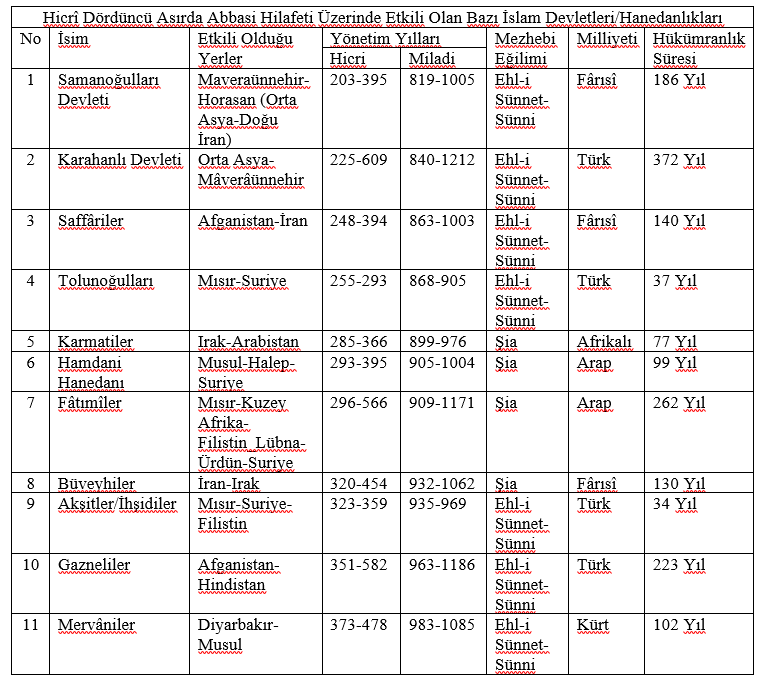
When we look at the states that had relations with the Abbasid caliphate in this period and had very serious effects on the caliphate from time to time, we see the existence of around 10 states and dynasties as shown in the table on the right. Some of these states and dynasties were established before the fourth century, the century we are focusing on here, and continued their life after this century. Some of them emerged in this century; some of them disappeared in this century. These were mostly Turkish and Iranian states. In terms of sect, they mostly belong to the Ahl al-Sunnah/Sunni tendency.
In terms of religious sciences, we see that the fourth century of Hijri was very productive like the third century. Although the science of tafsir was formed in the first two centuries of Hijri, it was in the third century of Hijri that tafsir activities were carried out intensively. In this period, a large number of tafsirs, especially linguistic tafsirs, and prominent commentators stand out. The most important works in the science of tafsir were written in the fourth century. We can say that the first work that comes to mind when we talk about tafsir is Abū Ja’far Ibn Jarīr al-Tabarī’s Jāmi al-bayān an ta’wīli āyi’l-Qur’ān. If this enormous work of al-Tabarī is ignored, it is certain that there will be a great deficiency in tafsīr. It can be said that the predominant aspect of this work is narration. Another important work like this one is the work of Abū Mansūr Muhammad Māturīdī’s Ta’wīl al-Qur’ān, in which the dirāyah aspect is prominent. This work, also known as Ta’wīlāt al-Ahl al-Sunnah, is a complete tafsīr. Other scholars who wrote very important exegesis in the fourth century of Hijri can be given as follows: Abū ‘Alī al-Jubbā’ī, Abū al-Qāsim al-Balkhī, Abū Ishaq al-Zajjāj, Abū Bakr Ibn al-Munzir, Abū Muslim al-Isfahānī, Ibn Abī Hātim al-Rāzī, Abū Ja’far al-Nahhās, Abū Bakr al-Jaṣṣās, Abū al-Lays al-Samarqandī, Ibn Abī Zamanīn. These are the ones who have gained fame. Although not as much as these, there are still other names that are important in tafsīr.
Some of them wrote their tafsīrs based on the method of narration, while others adopted the method of dirāyah. There are also many tafsirs written on the basis of methods such as ahkām, lexicon, and mysticism. Again, while some of these exegetes adopted the Ahl al-Sunnah understanding, others such as al-Jubbāʾī, al-Balkhī, al-Isfahānī wrote their works based on the Mutazilite understanding. Scholars such as Abu’l-Qāsim Furat al-Kūfī, Abu’n-Nasr al-Ayyāshī al-Samarqandī, Abu’l-Hasan Ali b. Ibrahim al-Kummī wrote their commentaries based on the Shi’ite mentality.
Although Hijri fourth century is more important in terms of the science of hadith, the fourth century is also of considerable importance. Abu Abdirrahman al- Nasā’ī, who died at the beginning of the century, is the author of one of the most important books of Sunan. Al-Nasā’ī is also an important commentator who has a tafsir. Abu’l-Qasim al-Tabarānī is an indispensable scholar in the science of hadith. He added a lot to the science of hadith with the Mu’jams he wrote. Tabarani also has an important work on tafsir called al-Tafsı̄r al-Kabı̄r. Abū Ya’la al-Mawsilī, Abū Bakr Ibn Khuzayma, Abū ‘Awāna al-Isferāyinī, Abū Hatim Ibn Hibbān, Abū al-Hasan al-Dāraqutnī, Abū Muhammad Rāmhurmuzī, who wrote the first work in the field of hadith methodology, and many other important hadith scholars lived in this period and wrote important works. This century was also a century in which classification types such as mustadrak and mustahraj came to the fore. The first examples of atraf hadiths and annotation on previous hadith books were also written in this century. Al-Kāfī, which is valued by the Shia in the same way as Bukhārī’s position in the eyes of the Ahl al-Sunnah, was prepared by al-Qulaynī in this period.
The fourth century of Hijri is very important, especially in terms of the theological sects. While the Mutazilite sect started to grow stronger and spread throughout the region with the support of the government from the second century onwards and became institutionalised thanks to this great interest, the Ahl al-Sunnah did not yet have an institutionalised structure. Although Imam Malik, Imam Shafi’i, Ahmad b. Hanbal and some other scholars, starting from Imam Abu Hanifa, dealt with the theological issues in their works, but a disciplined sect of Ahl al-Sunnah had not yet emerged in this regard. Abu’l-Hasan al-Ash’arī and Abū Mansūr al-Māturīdī, who emerged in this century, established two major theological sects of the Ahl al-Sunnah school and gave them an institutional identity. Al-Ash’arı̄ was initially a member of the Mutazilite sect, but he found the views of this sect contrary to the evidence and reason, so he left this sect and founded his sect. Both of these scholars are scholars of the fourth century of Hijri. Today, the majority of Muslims belong to the Ash’ariyya sect founded by Abu al-Hasan al-Ash’ari, and the other part belongs to the Māturīdiyya sect founded by Abu Mansūr Māturidī. Apart from this, Abū ‘Ali al-Jubbā’ī and Abu’l-Qasim al-Balkhī, besides being scholars of tafsir, were also very important Mutazilite theological scholars and defended their sect fervently. Sheikh Mufid and Ibn al-Juham are also important theological scholars of Shia.
In terms of the science of fiqh, although the practical fiqh sects emerged and took shape earlier, the institutionalisation of these sects and the formation of their founding texts continued to increase in this century. Abu Ja’far al-Tahāwī and Abu Bakr al-Jaṣṣās, who are both exegetes, are also great jurisprudential scholars. In particular, some of the most important of basic procedural works of Hanafi fiqh were written by these two scholars. Abu ‘Ali al-Bardaı̄, Abu’l-Hasan al-Karhı̄, Abu Bakr al-Iskāf, Abu’l-Lays al-Samarqandı̄, who was also an exegete, are some of the scholars who served the spread of the Hanafi madhhab in this period. Likewise, very important scholars of the Shafi’i, Mālikī and Hanbalī sects produced works that constitute the basis of their sects in this century. Abu’l-Abbas Ibn Suryaj, Abu’l-Abbas Yaqūb b. Ishaq, Abu’l-Abbas Yaqūb b. Asamm, Abū Bakr Ismail al-Kaffāl al-Kabīr are some of the scholars who spread the Shafi’i sect in this century. Scholars such as Abū Bakr al-Khalāl and Abu’l-Qasim al-Khirāqī also rendered great service to the Hanbali sect in this century. Scholars such as Ibn Abī Zayd al-Qayrawānī, Abū ‘Umar al-Mālikī, Ibrahim b. Ishaq b. Abī Zard al-‘Amawī al-Tuwaytulī also spread the Maliki sect. The most important names in terms of Jafari/Shi’i jurisprudence are al-Quwaynī and Ibn Babawayh al-Qummī, who were also important hadith scholars.
Abū Bakr Ibn al-Anbārī also wrote important works in the field of Qira’ah as well as Arabic language. Abu Bakr al-Naqqāsh also performed important services in the field of Qira’ah in addition to his exegesis. Ibn Abī Dāwūd al-Sijistānī’s Kitāb al-Masāhif; Abū Bakr Ibn Mujahid’s Kitāb al-Sab’a fi al-Qiraāt; Abū Bakr Ibn al-Anbārī’s Kitāb Izāhi al-Waqfī wa al-Ibtidā; and Abū Ja’far al-Nahhās’ al-Qat’ wa al-Itnāf, who was also an important exegete, are also very valuable works in the field of Qira’at in this century. Among the other noteworthy Qiraat scholars of the century, we can mention Abu Mansur al-Azharī al-Kharawi, Abū ‘Abdillah Ibn Khālawayh, Abu’l-Fath Ibn Jinnī, Ibn Ghalbūn, Abū Bakr b. Mihrān.
In the field of lexicography, in addition to scholars such as al-Zajjāj and al-Naḥḥās, who were also commentators, we should also mention Abū ‘Ali al-Fārisī and his student Ibn Jinnī, both of whom have numerous works on grammar. Ibrahim b. Muhammad b. Arafe Nafduye is also an important lexicographical scholar. In terms of the Andalusian linguistic school, Abu Bakr Muhammad al-Zubaydī should be mentioned.
In the field of history, the most important work of the period and perhaps of all periods, Tārı̄hu al-Umam wa’l-Mulūk, and its author Ibn Jarir al-Tabari, Murūj al-Zahab, Ahbār al-Zamān, works such as al-Tanbih wa’l-Ishrāf and its author Abu’l-Hasan ‘Ali al-Mas’ūdī, the work Ahl al-Nabi wa ‘adābuhu and its author Abu al-Sheikh Ibn Hayyān al-Isfahāni are important works and historians that should be mentioned.
In Sufism, Hallaj al-Mansūr, Abū Nasr al-Sarrāj, Abū Said b. ‘Arabī, al-Hakīm al-Tirmidhī, Muhammad b. Ibrahim al-Kalābāzī, Abū Talib al-Makkī are the most important Sufi scholars of the period. In this period, Sufism started to become an independent discipline with masail, mabadi’ and metodology by concentrating on some basic issues and emerged as a science. Sufis had some debates within themselves on some issues, especially shatahat and semai tawakkul, and were also criticised harshly by members of some non-Sufism disciplines.
In the field of philosophy, the most important scholar of the period was Abu’n-Nasr Muhammad al-Farabi. Al-Farabi grounded Islamic philosophy in terms of method, terminology and problems. Other scholars also engaged in philosophy in this century.
Abu Bakr b. Hudhayme Muhammad b. Zakariya al-Razi was an important scholar of the period who wrote works in the field of medicine. Ali b. Abbas and Ali b. Isa also made important services in the field of medicine in this period. In this century, there are also scholars who wrote works in fields such as history, siyar, geography, and sociology as well as medicine.
Some important events were also realised in this century. One of the most important events of the period was the terror of the Qarmatians in the first twenty years of the century. They committed massacres both in Iraqi cities such as Basra, Baghdad, Kufa and in two holy cities of the Hijaz region such as Mecca and Medina. They removed Hajr al-Aswad from its place and kept it with them for 22 years. Only after that they brought it back and put it in its place. During this period, there were various internal revolts and disturbances, the dismissal, murder or torture of the caliphs, attacks on the caliphate by the rulers of some Muslim states, some economic problems, some revolts based on religion and sect, the outbreak of some epidemics, especially in Baghdad and its surroundings, the proliferation of rabies cases to an unpreventable extent, the death of thousands of people due to these diseases, earthquakes, excessive rains and some similar natural disasters.
As can be seen, the fourth century of Hijri was a very active and productive century in terms of many sciences. Accordingly, all the scholars who died between the dates mentioned in the fourth century of Hijri are within the scope of the symposium. Books written between these years, sects established, important events that took place, important services rendered, and important institutions established are also among the subjects of the symposium.
Important wars fought in this century, new conquered regions, political events, relations with neighbouring countries, social and economic mobility are also within the scope of the symposium.
Symposium Partners
We organized this symposium as Istanbul University Faculty of Theology, Jāmiat Abd al-Malek al-Sādi Kulliyat Usūl al-Dīn Deanate (Morocco/Titwan); Directorate of Muhteberu Kadaya al-Tajdīd fi’d-Dirāsāti al-Islamiyya wa’l-Insāniyya (Morocco/Oujda) within the Cāmiatu Muhammad al-Awwal Faculté Pluridisciplinaire, the Directorate of Muhteberu’l-Ulūm al-Islāmiyya (Morocco/Titvan) within the Jāmiat Abd al-Malek al-Sādi Faculté Pluridisciplinaire and the Directorate of the Higher Islamic Institute in Sofia (Bulgaria).
Scope
In this book, it is aimed to deal with all these important events that took place in the fourth century of Hijri (between 300-399 AH / 913-1009 AD), the people who lived in this period, the works written, the concepts and subjects produced, especially within the framework of their relevance and relationship with the period.
Topics
Historical Studies: All people, works, topics and terms in the fields of Sirah and Islamic History, Civilization History, Institutions History, Art History in the fourth century AH.
Qur’anic Studies: All persons, works, topics, and terms that fall into the field of Mushaf Studies, History of the Qur’an, Qıraat, History of the Qıraat, Ulumu’l-Qur’an, Tafsir, Methodology of Tafsir and History in the fourth century AH.
Hadith Studies: All persons, works, topics and terms included in the scope of Hadith, Methodology Hadith and History in the fourth century AH.
Islamic Law Studies: All persons, works, topics and terms included in the scope of Fiqh, Methodology of Fiqh and History in the fourth century AH.
Fiqh Studies: All developments, persons, works, subjects and concepts within the scope of Fiqh, Usūl al-Fiqh and History in the fourth century of Hijri.
Aqāid Studies: All the people, works, topics and terms that fall under the scope of Kalam/Aqidah, History of Kalam, History of Islamic Faith Sects, History of Religions in the fourth century AH.
Linguistic Studies: Arabic Language, Rhetoric and History of the in the fourth century AH, all the people, works, topics and terms that fall under the scope of other languages used by Muslims.
Sufi Studies: All persons, works, topics and terms included in the History of Sufism and Sufism in the fourth century AH.
Studies in Philosophy and Islamic Thought: All persons, works, topics and terms included in Philosophy, Logic, Islamic Thought, History of Islamic Thinking in the fourth century AH.
Religion and Politics Studies: All people, works, topics and terms related to the relationship between Religion and Politics in the fourth century AH.
Medicine and Natural Sciences: The state of natural sciences in the fourth century AH and their relations with religious sciences and all developments, people, works, topics and terms in this field.
Some Matters Regarding the Contents of the Papers
In this context, the following issues should be noted regarding the papers:
1 – The works to be sent must be original. A work previously published elsewhere will not be accepted if it is sent in its original form or with some minor changes.
2 – The author should be dealing with the subject from a new and different perspective. Studies that deal with a known subject with known methods will not be accepted.
3 – It must be absolutely related to the period. Subjects outside the Hijri 300-399 range will not be accepted.
4 – The work must be published here for the first time. Friends with a thesis related to the period can prepare and submit the relevant topic anew, presenting it in a different form than its current state.
5 – Studies must be handled in a scientific and academic style.
6 – Only one chapter per person will be accepted in the book.
7 – Submissions can be in Turkish as well as in Arabic and English.
8 – There is no fee for publication, and no compensation will be provided to any contributor for their work.
9 – The length of submissions should be no less than 5,000 words and no more than 17,000 words.
10– The sender of the work must name his file as follows: For example: Tafsir_H_Aydar; Hadis_H_Aydar; Like Kelam_H_Aydar. First, he should write the field of the work he sent, and then write his name and surname.
11- Submissions must strictly adhere to the template provided below. Submissions that do not conform to the template in terms of formatting will not be accepted.
THE TEMPLATE TO BE BASED ON WHEN WRITING THE BOOK CHAPTER (ISNAD CITATION STYLE)
1 – In order for the articles to have integrity and to make the typesetting more comfortable, the author must obey the following points and write his article accordingly.
2 – The studies will first be examined by the editorial board and then evaluated by the science committee. The studies that do not comply with the points stated here or that are not original will not be published.
3- In the articles, the Citation Attribution System (İsnad Atıf Sistemi) can be based on the first, second, or third version. Participants must prepare their articles according to this system, and articles not prepared accordingly will not be accepted.
4 – It is mandatory to provide the English version of the titles as follows:
TAFSIR IN THE FOURTH HIJRI CENTURY
5- The author information must be presented as follow:
Hidayet Aydar
Prof. Dr., Istanbul University, Faculty of Theology, Department of Tafsir, Istanbul Turkiye hidayet@istanbul.edu.tr Orcid.org/0000-0002-7563-5073
6- Heading Format in Decimal System:
- ______________________________________
1.1. ________________________________
1.1.1. ________________________
- _______________________________________
2.1. ____________________________________
2.1.1. ______________________________
All letters in first titles should be written in capital letters and bold as examples are given below:
INTRODUCTION (The study should not contain Abstract, Preface or similar titles, It should start directly with the title of Introduction)
1 – In this part of the chapter, the author should initially address the subject/person/concept/event, etc., to be discussed in terms of its historical background. In other words, they should concisely describe what has transpired in that area from the beginning to the period they will be focusing on in their study.
2 – Then, the author should outline the specific topics to be addressed in this study.
3 – Subsequently, the author should investigate whether any previous studies or similar works have been conducted on the subject. If so, they should discuss these and highlight the distinctive and original aspects of their own work in comparison.
4 – If there is no existing research on the topic or if no similar studies have been conducted, this should also be indicated.
5 – The author should then specify the research methodology, explaining the principles and procedures under which the study was conducted.
6 – Finally, the author should articulate how they intend to contribute to the field with this study, outlining the significance of the contribution they aim to make.
Conclusion
1-In the conclusion, the subject should not be summarized, the results obtained from the study should be emphasized, these can be given with items or in paragraphs without item.
2-Also in this part of the study, the difficulties experienced in the study should be mentioned. If it has the missing parts, it should be also mentioned, and if possible, suggestions should be made to others about the studies to be written in this field.
Page Layout: Right, left, bottom, top 2.5
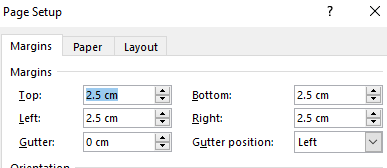
Paragraph spacing: It will be as follows
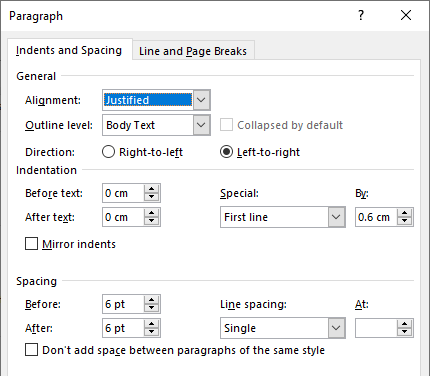
Footnote: It will be as follows
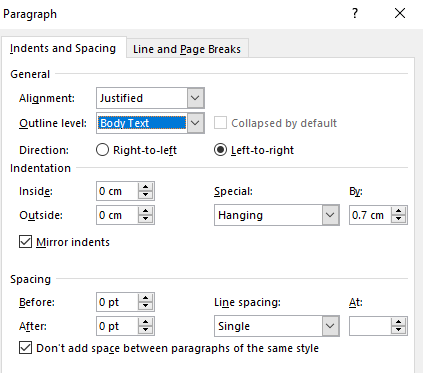
Font style:
In the text: Times New Roman 12
In footnotes: Times New Roman 10
Notes:
1 – DIA (Türkiye Diyanet Vakfı İslâm Ansiklopedisi) will be the basis for the writing of words such as person, work, city, country, place name in the text.
2 – If it is not included in the DIA, the author can choose the most appropriate spelling. This spelling should be the same throughout the text, that is, there should be in-text consistency.
3 – English writing of titles:
Prof. Dr. = Prof. Dr.
Doç. Dr.= Associate Prof.
Dr. Öğretim Üyesi = Dr. Faculty member
Öğretim Görevlisi = Teaching Assistant
Araştırma Görevlisi = Research Assistant
Doktora Öğrencisi = PhD Student
Yüksek Lisans öğrencisi = Master Student
The dates of death of the people mentioned in the text are stated as “(d. AH / CE)” where they are first mentioned: Abū Isḥāq al-Ṣaffār (d. 534/1139).
Apostrophe Usage: “al-Ṣaffār’s (d. 534/1139) defence of kalām …”.
Writing and Citing of the verses: “For, Believers are those who, when Allah is mentioned, feel a tremor in their hearts.” (al-Anfāl 8/2).
Citing the Torah and the Bible: Genesis 11/25. Matthew 1/13.
Citing Hadith Sources (Should be based on the İsnad Atıf Sistemi):
The İsnad Atıf Sistemi should be followed in footnotes and the bibliography.
1 – Those who wish to write a book chapter with the specified qualifications must submit an Introduction section of at least 800 words that reflects the original and distinctive aspects of the chapter’s content, following the principles mentioned above. The submission should be sent to the institutional email address (hicridorduncuasir@istanbul.edu.tr) by January 31, 2024, Wednesday, at 23:59 in the specified format.
2 – The Introduction sections of the articles will be reviewed by the editorial board. Those deemed suitable will be sent to the scientific board members in the field. Entries approved by the members will be accepted, those requiring changes will be returned to the author for necessary modifications, and after the changes are made, the process will proceed. Entries unanimously rejected by the members will not be considered. Articles where one member expresses a positive opinion and another a negative one will be sent to a third member for evaluation. Entries approved will be announced on February 11, 2024.
3 – The full text of accepted articles must be submitted to the institutional email address (hicridorduncuasir@istanbul.edu.tr) by July 31, 2024, Wednesday, at 23:59.
4 – The articles will be reviewed by the Editorial Board, and if corrections or changes are requested, they will be returned to the author for implementation. The final version of the articles, as given by the author, must be sent to the above-mentioned email address by August 31, 2024.
5 – After all these processes are completed, the book will be electronically published by an international publishing house in 2024 and presented to the public as an edited book.
Who Can Participate:
Researchers and academics at all levels working on the specified topics are welcome to participate.
Important Dates:
Deadline for submitting the Introduction: January 31, 2024
Announcement of accepted articles: February 11, 2024
Deadline for submitting the full text: July 31, 2024
Deadline for submitting the corrected version: August 31, 2024
Editorial Board:
Prof. Dr. Hidayet Aydar, Faculty Member, Istanbul University Faculty of Theology
Assoc. Prof. Dr. Ziyad Ravaşdeh, Lecturer, Istanbul University Faculty of Theology
Dr. Faculty Member Selim Çakıroğlu, Faculty Member, Istanbul University Faculty of Theology
Dr. Khadeejeh Alrawashdeh, Istanbul University Language Center
Res. Assist. PhD Student Feyza Çelik, Kilis 7 Aralık University/Istanbul University
PhD Student Hatice Ece Erçin, Turkey/Istanbul University
PhD Student Hani el-Guşhaymi, Fatih Sultan Mehmet University
Res. Assist. PhD Student Habibe Elmas, Muş Alparslan University/Istanbul University
Master’s Student Abass Magham, Istanbul University
[1] Tarih Bilimi, “Abbasi Halifeleri Dönemi”, erişim: 14.05.2022, https://www.tarihbilimi.gen.tr/abbasi-halifeleri-donemi/
